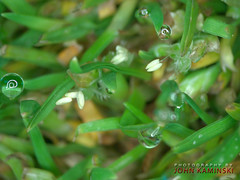 Two weeks ago I mentioned the posting of an international update from a recent trip to Europe and the UK. While overseas, I had the chance to speak with the Dutch Greenkeepers Association and the greenkeepers of the Southwest Region of the British & International Golf Greenkeepers Association. The trip was a great opportunity to visit a couple of golf courses in Holland and also hear about some disease updates in the UK from Ruth Mann of the Sports Turf Research Institute.
Two weeks ago I mentioned the posting of an international update from a recent trip to Europe and the UK. While overseas, I had the chance to speak with the Dutch Greenkeepers Association and the greenkeepers of the Southwest Region of the British & International Golf Greenkeepers Association. The trip was a great opportunity to visit a couple of golf courses in Holland and also hear about some disease updates in the UK from Ruth Mann of the Sports Turf Research Institute.Golf Course Visits:
 While in the Netherlands, we took a day trip to visit two golf courses including the Kennemer Golf Club (site of the Dutch Open) and the Golf Club De Pan. Both courses were very unique and a treat to see. One of the most unique aspects were the Nazi-built concrete bunkers at the Kennemer Golf Club. These were constructed during the Nazi occupation of the Netherlands during World War II. These bunkers are still used on the course for the maintenance facility as well for several storage areas for maintenance supplies and equipment.
While in the Netherlands, we took a day trip to visit two golf courses including the Kennemer Golf Club (site of the Dutch Open) and the Golf Club De Pan. Both courses were very unique and a treat to see. One of the most unique aspects were the Nazi-built concrete bunkers at the Kennemer Golf Club. These were constructed during the Nazi occupation of the Netherlands during World War II. These bunkers are still used on the course for the maintenance facility as well for several storage areas for maintenance supplies and equipment. From a disease perspective, there was plenty to see, but not enough that caused much concern for the greenkeepers as playability did not appear to be impacted. The main problem with playability came with the earthworm castings on the fairways which was causing severe problems. Other common problems appeared to be fairy ring and red thread. Interestingly enough, most of the damage on the fairways had the visual symptoms of dollar spot, but closer examination of all of the spots revealed the presence of red
From a disease perspective, there was plenty to see, but not enough that caused much concern for the greenkeepers as playability did not appear to be impacted. The main problem with playability came with the earthworm castings on the fairways which was causing severe problems. Other common problems appeared to be fairy ring and red thread. Interestingly enough, most of the damage on the fairways had the visual symptoms of dollar spot, but closer examination of all of the spots revealed the presence of red  sclerotia. There is a good possibility that this was a complex of the two diseases, but without isolation it was impossible to tell if dollar spot was also involved. In addition to these common diseases, we also saw a few areas with yellow tuft, which was really of no surprise due to the excessive amount of precipitation that the area had received during the year.
sclerotia. There is a good possibility that this was a complex of the two diseases, but without isolation it was impossible to tell if dollar spot was also involved. In addition to these common diseases, we also saw a few areas with yellow tuft, which was really of no surprise due to the excessive amount of precipitation that the area had received during the year.Disease Update from Ruth Mann:
Ruth Mann manages the Turfgrass Protection Department of the STRI and has extensive experience dealing with disease on golf courses in the UK. Dr. Mann gave a great update on turfgrass diseases in the UK. According to Ruth, dollar spot and leaf spot diseases are definitely on the rise in the UK. Ruth made specific mention to the changing weather in the region and revealed that temperatures have increased by 0.15C in the past few years. She also lightheartedly mentioned the mote that she had to drive around to get out of her hometown to make it to the meeting after some major flooding in the UK (Story here). Ruth went on to caution turfgrass managers about curative control of chronic dollar spot in particular as it is not always the most effective. Other diseases that continue to be a problem included Fusarium patch (Microdochium patch, aka Pink snow mold) and of course fairy ring.
Fairy Ring and Other Issues:
 My talks involved a discussion of the principle of managing fairy ring, a disease that greenkeepers in the UK and Europe are all too familiar with. However, management practices that superintendents in the US often take for granted are now just becoming increasingly popular overseas. Some of these practices include the use of wetting agents and the use of the plant growth regulator trinexapac-ethyl. While these supplemental cultural practices are resulting in improved turfgrass health and quality, they are being met by an increase in management intensities. For instance, there was a debate among some of the greenkeepers in the UK regarding mowing heights. While most felt that keeping heights around 5 mm (~0.2") is going to make for a sustainable turfgrass, others felt that lowering heights as low as 2 mm (~0.079) is manageable (remember that many of the greens are fescue and highland bentgrass, not the typical creeping bents and Poa managed in the northeast). Additionally, there is increased interest in the idea of minimal disturbance (no hollow cultivation) and reduced nitrogen fertility. Perhaps I am just cynical, but it appears to me that in the greenkeepers attempt to meet the powers-that-be's goal of "sustainability", they are basically heading down the road of turf management practices of the United States. These practices will likely be met with more intense disease pressure (as they now seem to be seeing). Whether the increased disease pressure is the result of rising temperatures or changes in the weather patterns OR whether this is the direct result of more intense management practices will remain debatable.
My talks involved a discussion of the principle of managing fairy ring, a disease that greenkeepers in the UK and Europe are all too familiar with. However, management practices that superintendents in the US often take for granted are now just becoming increasingly popular overseas. Some of these practices include the use of wetting agents and the use of the plant growth regulator trinexapac-ethyl. While these supplemental cultural practices are resulting in improved turfgrass health and quality, they are being met by an increase in management intensities. For instance, there was a debate among some of the greenkeepers in the UK regarding mowing heights. While most felt that keeping heights around 5 mm (~0.2") is going to make for a sustainable turfgrass, others felt that lowering heights as low as 2 mm (~0.079) is manageable (remember that many of the greens are fescue and highland bentgrass, not the typical creeping bents and Poa managed in the northeast). Additionally, there is increased interest in the idea of minimal disturbance (no hollow cultivation) and reduced nitrogen fertility. Perhaps I am just cynical, but it appears to me that in the greenkeepers attempt to meet the powers-that-be's goal of "sustainability", they are basically heading down the road of turf management practices of the United States. These practices will likely be met with more intense disease pressure (as they now seem to be seeing). Whether the increased disease pressure is the result of rising temperatures or changes in the weather patterns OR whether this is the direct result of more intense management practices will remain debatable. In the United States, golf course management seems to go in cycles (graph courtesy Adam Moeller, agronomist for Northeast green section of USGA). Ten to fifteen years ago, turf managers were on a kick to keep it "lean and mean" (and many still subscribe to this) and were met with increased outbreaks of dollar spot and anthracnose. In fact, these two diseases are probably the most important diseases of golf course turf in the Northeastern United States. Superintendents also continue to utilize PGRs and improved equipment to reduce mowing heights to sub 0.10" heights in an effort to chase green speeds for the membership. Luckily, most superintendents are now getting a better handle on adjusting seasonal fertility rates to manage these diseases. Unfortunately, it doesn't look like mowing heights will ever go back up from the extremes we have pushed them to. My point? It seems to me (albeit with limited experience with turf management in the UK and Europe) that if turf managers overseas continue down the road they are currently on, their turf will be met with increased percentages of Poa annua and increased dollar spot and other low N or excessive-thatch diseases. This will ultimately result in the need for increased fungicide use, which is the exact reason the idea of "sustainability" has become widely promoted by the R&A.
In the United States, golf course management seems to go in cycles (graph courtesy Adam Moeller, agronomist for Northeast green section of USGA). Ten to fifteen years ago, turf managers were on a kick to keep it "lean and mean" (and many still subscribe to this) and were met with increased outbreaks of dollar spot and anthracnose. In fact, these two diseases are probably the most important diseases of golf course turf in the Northeastern United States. Superintendents also continue to utilize PGRs and improved equipment to reduce mowing heights to sub 0.10" heights in an effort to chase green speeds for the membership. Luckily, most superintendents are now getting a better handle on adjusting seasonal fertility rates to manage these diseases. Unfortunately, it doesn't look like mowing heights will ever go back up from the extremes we have pushed them to. My point? It seems to me (albeit with limited experience with turf management in the UK and Europe) that if turf managers overseas continue down the road they are currently on, their turf will be met with increased percentages of Poa annua and increased dollar spot and other low N or excessive-thatch diseases. This will ultimately result in the need for increased fungicide use, which is the exact reason the idea of "sustainability" has become widely promoted by the R&A.My final thoughts:
In discussing these issues with greenkeepers in the UK, I found that there is much internal debate on some of these topics. The best argument I heard was that "the more we do, the more problems we seem to have." I agree completely, but the challenges are the same as we have in the United States (envy and egos). Once golfers see the quality of the course down the street (whose greenkeeper is not letting nature take its course), they are going to start asking for similar conditions. And so the cycle will continue.
A special thanks to our hosts
This was a great trip and I appreciate all of the warmth and hospitality shown during the tour (and I look forward to the Scrumpy on my next trip). I truly love golf and golf course management in the UK and Europe. Despite all of the "advances" and demand for increased turf quality in the US, the fact that golf in the UK/Europe is still about the playability and not (not yet) about the emerald green look says a lot about priorities surrounding the game of golf.
Check out some photos from the trip below.


























